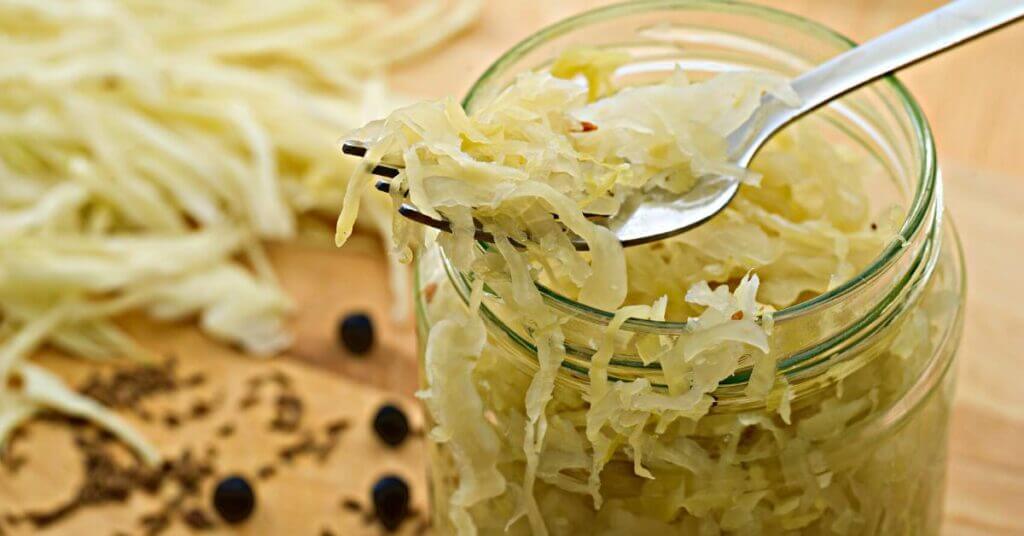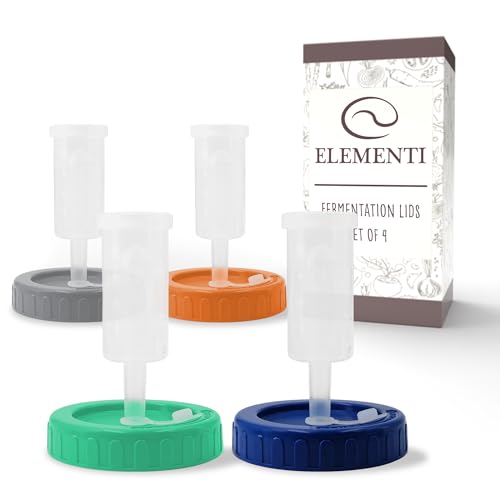Making homemade sauerkraut is a straightforward process.
Let’s learn how!
Quick Overview: The Process of Making Sauerkraut in a Nutshell
Sauerkraut is a delicious fermented food with numerous health benefits, and you can make it yourself at home in just a few simple steps:
1. Prepare the cabbage: First, you’ll need to choose a fresh, firm head of cabbage. Remove the outer leaves, then cut the cabbage in half through the stem end. Proceed to shred the cabbage using a sharp knife, mandoline, or food processor. You will need about 2 heads of cabbage for a 2-liter jar of sauerkraut. (For a half-gallon Mason jar, use 5 lbs of cabbage.)
2. Add salt: Combine the shredded cabbage with about 3 tablespoons of non-iodized salt. This helps extract the liquid from the cabbage and creates a brine that allows the fermentation process to begin. Toss the cabbage and salt together until well mixed.
3. Pack the jar: Next, you’ll need to pack the cabbage tightly into a clean glass jar or fermentation crock. Avoid plastic. Traditional earthenware crocks are a popular choice, but it’s very important they are not cracked or chipped. Press down firmly to remove any air pockets and ensure the cabbage is completely submerged in its own brine. Leave about 1-2 inches of headspace at the top of the jar to allow for expansion during fermentation.
4. Weigh it down: To keep the cabbage submerged and anaerobic, place a clean, smaller jar or fermentation weight on top. Make sure no cabbage pieces are exposed to air as this could lead to mold or spoilage.
5. Ferment: Place a lid loosely, or cover the jar with a breathable cloth secured by a rubber band. Store the jar in a cool, dark place and let the cabbage ferment for 1-6 weeks. It seems most people wait for that 4-6 week window.
6. Store: Once the sauerkraut has reached your desired level of sourness, transfer it to the refrigerator to slow down the fermentation. If you have a cool cellar or basement that stays between 40-50°F, you can store it there.
Choosing Ingredients
When making sauerkraut, the foundation of the recipe lies in the selection of good-quality ingredients.
Choosing the right cabbage, salt, and other flavor-enhancing ingredients can transform your homemade sauerkraut into a delectable, probiotic-rich food.
Cabbage: Start by selecting a firm and fresh green cabbage, which will be the primary ingredient for your sauerkraut. Green cabbage is the most commonly used variety for sauerkraut, but you can also experiment with other types if you prefer.
Sauerkraut is a great product to make with a fresh cabbage harvest.
Salt: Go for good quality and non-iodized salt, such as pickling, kosher, or sea salt. Iodized salt can inhibit the fermentation process, affecting the taste and texture of your sauerkraut. Here’s a detailed breakdown of the types of salt you can use for canning and fermenting.
Once you have the basics covered, consider adding some optional ingredients to enhance the flavor of your sauerkraut:
-
Caraway Seeds: Caraway seeds introduce an aromatic and slightly earthy flavor. Just a teaspoon of caraway seeds is enough to make a noticeable difference.
-
Onion and Garlic: Adding a finely chopped onion and a couple of minced garlic cloves can add depth and savoriness to your sauerkraut.
-
Carrots: Shredded carrots contribute a touch of sweetness, color, and extra crunchiness to your sauerkraut.
-
Granny Smith Apples: Chopped granny smith apples provide a subtle tangy sweetness and pleasant crunch. Their tartness complements the sourness of the fermented cabbage.
-
Sweet Onions: Thinly sliced sweet onions contribute a mellow, sweet flavor and a different texture to your sauerkraut.
Remember, making sauerkraut allows for creativity and personal taste preferences. Just ensure that you maintain a proper ratio of cabbage to salt—about 1 1/2 to 2 teaspoons of salt per pound of cabbage—to ensure a successful fermentation process.
Perfecting the Brine
When making sauerkraut, creating the perfect brine is essential. Brine is a combination of water and salt that helps preserve and enhance the flavor of the cabbage during the fermentation process.
Start by choosing the right salt for your brine. You have several options, such as pickling salt, sea salt, or kosher salt.
Whichever you choose, it should be free of additives and anti-caking agents. Pickling salt is usually the best option, as it dissolves easily and is pure.
Sea salt and kosher salt are also good choices but check to ensure they don’t contain additives.
You don’t need to worry about adding vinegar to your brine for sauerkraut since the fermentation process will naturally produce lactic acid, giving the sauerkraut its desirable tangy flavor.
Now let’s discuss the salting process. It helps to weigh your cabbage to determine how much salt you need. A rule of thumb is to use about 1 1/2 to 2 teaspoons of salt per pound of cabbage.
After chopping the cabbage, place it in a large bowl, sprinkle the salt, and massage or pound it to release the water from the cabbage.
The resulting brine should cover the cabbage when placed in a fermentation container.
If you find there is not enough brine after a few hours, you can easily make a supplemental brine by mixing 2% salt solution, which is 1 heaping teaspoon of salt per 1 cup of water.
Top up the cabbage with the additional brine so the cabbage is adequately submerged.
Remember to use filtered water, well water, or spring water for your brine, as tap water may contain chemicals or chlorine that could hinder the fermentation process.
Maintenance During the Fermentation Process
When making sauerkraut, the fermentation process is what transforms the raw cabbage into the tasty, tangy sauerkraut we all love.
Both gases and “surface scum” are natural byproducts of this process, so let’s talk about how to manage both.
For degassing, you can use an airlock system that allows the gases produced during fermentation to escape while preventing oxygen from entering the container.
Prices pulled from the Amazon Product Advertising API on:
Product prices and availability are accurate as of the date/time indicated and are subject to change. Any price and availability information displayed on [relevant Amazon Site(s), as applicable] at the time of purchase will apply to the purchase of this product.
This helps to maintain an anaerobic environment, which is essential for proper fermentation. If you’re using a mason jar, you can cover it with a lid and “burp” the jar daily to release the built-up gases.
This just involves opening the jar for a few minutes each day to let it degas.
Also, watch for any surface scum or “froth” to form on the surface, scoop it off and discard.
Customizing Your Sauerkraut with Spices and Herbs
Here are some popular options you can use to elevate your sauerkraut recipe:
Caraway seeds are a popular choice for sauerkraut, lending a slightly earthy, nutty taste to the mix. You can add a teaspoon of whole caraway seeds to a standard batch of sauerkraut, adjusting the amount according to your personal preference.
For a more pronounced flavor, slightly toast the seeds in a dry pan before adding them to your mixture.
Garlic also adds depth to your sauerkraut, giving it a savory kick. You can mince or thinly slice two to three cloves of garlic and mix them into your cabbage. If you’re not a big fan of garlic, feel free to adjust the amount according to your taste.
Including herbs like dill, rosemary, and thyme can introduce a fragrant, fresh dimension to your sauerkraut. Chop your chosen fresh herbs and add them directly to your cabbage mixture.
Dried herbs can also be used, but remember to use smaller quantities since their flavors are more concentrated.
Ground coriander can offer subtle citrus and spice notes to your sauerkraut. Add about half a teaspoon of ground coriander to your mix, and adjust the amount based on your preference.
Toasting the whole seeds and grinding them can also give you a more aromatic and potent spice.
Experimenting with other spices can lead to surprising and delicious flavor combinations in your sauerkraut. Some options to consider are mustard seeds, black pepper, and juniper berries.
Start with smaller amounts and build up the intensity of the flavors as needed.
Storing Homemade Sauerkraut
When it comes to storage, it’s essential to keep your sauerkraut in a cool place. The most common option is to store it in the refrigerator, where it can last for several months.
Be sure to keep the sauerkraut submerged in its brine and use a clean wooden utensil each time you serve it to prevent contamination.
If you’re short on fridge space, a cool basement or cellar is an alternative option for sauerkraut storage. Just bear in mind that it may not last as long outside the fridge, so check on it regularly.
FREE FOOD STORAGE PLAN!

Does gathering and storing a year’s worth of food for your family seem overwhelming and unachievable?
Make it easy with our step-by-step plan. Subscribe to our weekly newsletter & we’ll send it to you FREE!
If you need to store your sauerkraut for more extended periods, you can freeze it. Be sure to transfer the sauerkraut to an airtight container suitable for freezing, leaving some room for expansion.
Frozen sauerkraut will maintain its flavor and texture but may lose some beneficial bacteria during the freezing process.
As a friendly reminder, always use clean hands and utensils when handling sauerkraut to avoid introducing harmful bacteria.
When it’s time to enjoy your homemade sauerkraut, you have a variety of serving options. You can serve it cold as a side dish, add it to sandwiches or salads, or even heat it up and pair it with sausages or other protein sources.
Remember, heating sauerkraut can potentially reduce its beneficial bacteria, so try to keep it at a low temperature if you want to preserve its health benefits.
Dealing with Spoilage and Mold
During the fermentation process of making sauerkraut, it’s not uncommon for spoilage or mold to form. Don’t panic! There are ways to deal with these issues and salvage your sauerkraut.
Recognizing Mold: Mold can come in various colors, such as green, gray, pink, or black. If you notice a funky smell or slimy texture, these could also be indicators of mold. White surface scum is normal, but if it starts to look fuzzy, it’s likely mold.
Dealing with White Scum or Mold: If you spot pink or black mold, it’s best to discard the entire batch, as it can be harmful. If you see non-fuzzy white scum, that’s normal. You can simply skim it off the surface. If it’s mold, you’ll have to treat it a bit differently. Here is more detailed information on mold in sauerkraut.
Preventing Mold or Spoilage: To minimize the risk, make sure your cabbage is fully submerged in brine during the entire fermentation process. Use purified water, avoid anti-bacterial soap when cleaning your equipment, and stick to fine sea salt without any additives.
Homemade Sauerkraut Tips
Now let’s talk about how to make your homemade sauerkraut taste its best and how you can even speed up the process!
How to Make Sauerkraut Less Sour
If you prefer a milder taste for your homemade sauerkraut, you can try a few different methods. First, consider fermenting your cabbage for a shorter period. The longer the cabbage ferments, the sourer it becomes.
Another option is to add more water or a small amount of sugar to the mix, which can help balance out the acidity.
How to Make Sauerkraut Taste Good
To make your traditional sauerkraut taste better, consider adding a few flavorful additives. Here are some options to try:
- Herbs and spices: Feel free to experiment with your favorite herbs and spices. Caraway seeds, juniper berries, garlic, and even fresh dill are excellent choices that can give your sauerkraut a unique flavor.
- Veggies: You can also mix in other vegetables like sweet bell pepper, carrots, or even beets. This adds both color and taste to your sauerkraut.
- Variety of cabbage: Don’t be afraid to try different types of cabbage, like red, Savoy, or Napa. Each will bring its flavor and texture to your sauerkraut.
Remember to give your sauerkraut a taste test while it’s fermenting and make adjustments as needed to suit your taste buds.
How to Make Sauerkraut Extra Fast
When you’re in a hurry and want to enjoy homemade sauerkraut sooner, you can follow these steps:
- Use a food processor to slice your cabbage ultra-thin, which helps speed up the fermentation process.
- Heating your fermenting vessel can help speed things up as well. Place it in a warmer area of your home, like near a radiator or on top of the fridge. Just make sure the temperature isn’t too high, ideally between 68 and 72°F (20-22°C).
- Consider adding a starter culture to your cabbage, like whey or a store-bought sauerkraut starter. This will introduce more beneficial bacteria and speed up the fermentation time.
Keep in mind that speeding up the process may change the overall flavor profile. It might not be as complex as sauerkraut that has fermented for a more extended period. Plus, you’ll have to be very careful and watchful for any signs of developing mold.
When it comes to making sauerkraut, slow and steady is best.
If you decide you want buy instead of DIY, here are some of the best sauerkraut brands.
Frequently Asked Questions
How long does it take for sauerkraut to ferment?
Fermentation time for sauerkraut depends on various factors, particularly temperature and the amount of salt used. Generally, it takes about two to six weeks for sauerkraut to ferment properly. The ideal fermentation temperature is between 65°F and 72°F. Keep in mind that a cooler temperature will result in a slower fermentation process, while a warmer temperature may cause it to ferment more quickly.
What is the best sauerkraut to salt ratio?
The ideal sauerkraut to salt ratio is about 2% of the total weight of your cabbage. This typically translates to 1 1/2 to 2 teaspoons of salt per pound of cabbage. It’s important to use the correct amount of salt to ensure proper fermentation, as too much salt can inhibit the growth of beneficial bacteria, while too little salt might encourage the growth of harmful bacteria. It’s best to weigh your cabbage to determine the appropriate amount of salt.










